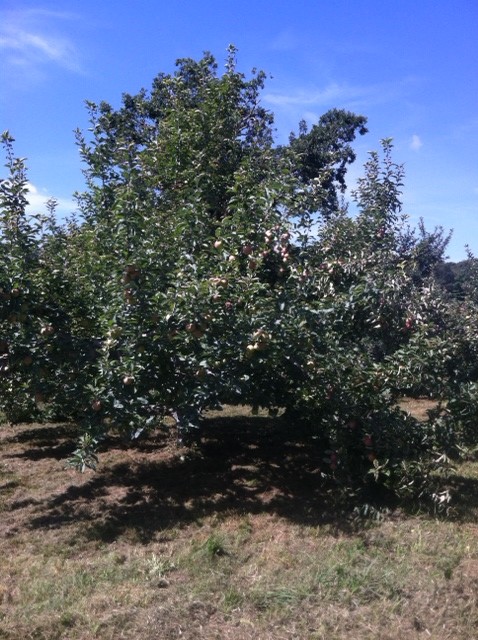Growing our certified organic apples at Hutchins Farm
Many of our customers have been asking for more information about how we grow our organic apples. We hope this answers a few questions, and gives you some insight into the challenges of organic farming!
The variable, unpredictable weather of New England and the predominance of both abandoned orchards and landscaped crab apples make growing organic apples a real challenge. The best orchard sites are on the heights and slopes of hills. Ours is pretty much a valley with heat and humidity. One would better choose soils a little less sandy than ours so that availability of moisture and nutrients was slower and more constant. Nevertheless we love our spot here in the Concord River Valley and do our best to grow good apples and we are proud to certify our practices as Organic.
We start the season worrying about Winter Moth, apple scab and anticipating a concern for fire blight. For the first we spray a light oil, making sure temps will not drop below 40 for at least 48 hours afterward. BT(bacillus thuringiensis) goes on several weeks later. The moths’ caterpillars are green and so small you can barely see them. Watch for their silk tracers as they drop in from taller surrounding trees, woodlands. Once they get inside the expanding buds, no organic materials can be effective. Copper addresses earliest emerging scab spores and may help with fire blight bacterium. No copper within two weeks of oil. Sulfur and lime sulfur take over as the primary scab season matures – here mid-April until late May.
Our use of Surround or kaolin clay in May usually begins when buds are showing pink. It has some beneficial effects on the scab problem and we believe initiates the discouraging process of telling some of the insect pests to go elsewhere. We might use one of the various new microbial products during bloom in hopes it might enhance a defense against fire blight. Commercial orchards – and some organic ones – use streptomycin materials at this time. We think that is not a healthy practice for our human environment.
After bloom(petal fall) begins the month period of maximum concern for insects. The apples are obviously small and super vulnerable. With our clay as a base we alternate the organically approved version of a soil derived bacterium spinosad called Entrust, with BT. In these sprays we include a seaweed extract and a tea we make from stinging nettle. Also boron. Hopefully we have controlled scab in its primary season. If June is wet me might have to continue some use of the sulfurs to minimize the spread of secondary scab.
In mid July and mid August we worry about a second generation of Codling Moth and the development in most seasons of Apple Maggot Fly. We try to time second sprays of BT and Entrust to maximize their impact. This year we have attempted to extend our impact on late season fruit worms by utilizing a new biological insecticide in Mid-August. It might have helped.
From early July through mid August we are also concerned with supplying calcium to the trees/fruit. There is only one material generally approved for Organic production, Calcium 25. We apply it three times by itself at a temperature above 80 so that it may be absorbed.
The summer diseases of Sooty Blotch and Fly Speck – they make our apples look dirty – are minimal in orchard sites that are elevated on hills with good airflow. We choose not to extend the use of sulfur and lime sulfur into August to reduce the two because sulfurs have a negative impact on soil life and the tissue of leaves and next year’s fruit buds when sprayed heavily. The diseases are harmless beyond their visual impact. Much can be washed off but we refrain in order to retain the natural waxes on the fruit surface. Removing the waxes reduces shelf life which is why markets carry so many apples that have actually been additionally waxed post harvest.
We rely much on the general weather pattern of Eastern Massachusetts that typically provides long periods of dry weather in August. Organic materials are only marginally protective. When we have a heavy crop, we have more “preferable” apples. Given a likely present insect population it has a big impact on a small crop perhaps affecting as many apples on the big crop, but leaving more unaffected. We sort the apples as we pick them and then again here at the stand trying to provide the best for you.
2013 has been a good year. Despite heavy early season rains most varieties came through with minimal scab. Late, extended dryness has kept fruit rots to a low level. The apples are firm and should store better than average. The Spencer, Empire and Sister will be in most plentiful supply later in October. We still will have Liberty, a terrific October apple. We should have a few Melrose and Jonagold. Buy your Macoun and Honeycrisp soon as they will disappear.
We hope this information is helpful to our customers. Thank you for your continued support of Hutchins Farm and local organic agriculture!
-John Bemis
One thought on “Growing our certified organic apples at Hutchins Farm”
Comments are closed.


Thank you for this detailed explanation. I will eat the honeycrisp apples I bought yesterday at the Belmont Farmers Market with much deeper appreciation of all the care that has been devoted to their successful maturation.